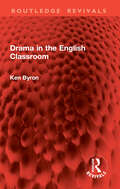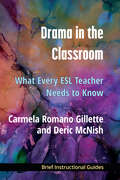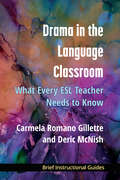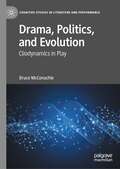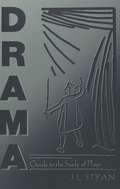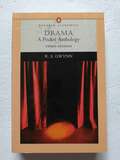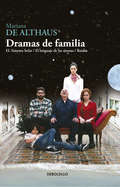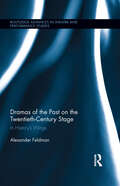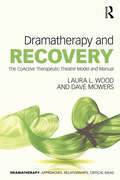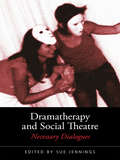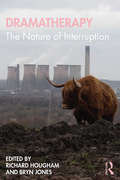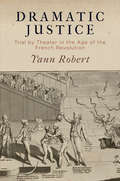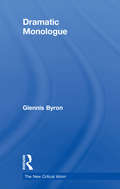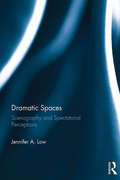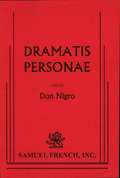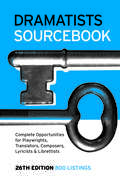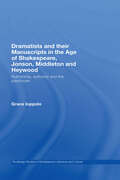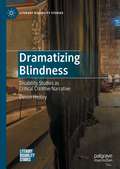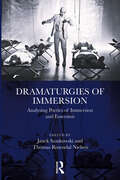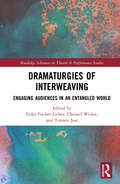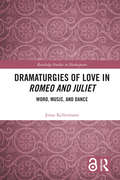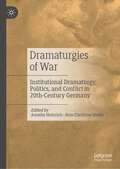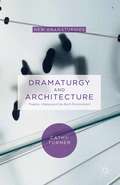- Table View
- List View
Drama in the English Classroom (Routledge Revivals)
by Ken ByronFirst published in 1986, Drama in the English Classroom demonstrates the contribution of drama in an English classroom. It suggests that drama activities, language work, and the reading of fiction can all enrich each other in ways which promote the aims of the English teacher.The author draws on his own classroom experience and on that of the teachers whom he guided (on long-term in-service work) through the process of learning to use drama effectively. He offers many examples to illustrate the opportunities and the problems of using drama in English. Planning, key drama strategies, major pitfalls, evaluation, and the rewards of drama are examined from the viewpoint of an English teacher who senses that drama has a great deal to offer in the classroom but is at first unsure of what and how. As major part of his book is presented in form of a teacher’s journal, we see the author trying things, reflecting on the result, talking to a more experienced colleague, and steadily finding out what drama can contribute and how he can achieve this in his teaching. This book is an encouraging and helpful guide for anyone who wishes to use drama effectively but is unsure of the first steps.
Drama in the Language Classroom: What Every ESL Teacher Needs to Know
by Carmela Romano Gillette Deric McNish"Our particular approach is built on the belief that using elements of drama and the performing arts in the language classroom works best when it builds on concepts of language development that have been tested and supported. As language scholars, we know that honoring students’ identities is important; that investment in the learning process must be nurtured; that learners respond to material that is engaging, relevant, and authentic; that learners must use the language and not just study it; and that affective factors can sometimes impede learning." ---Carmela Romano Gillette & Deric McNish This e-book weaves together cutting-edge research and practices from the fields of theater and TESOL. After providing an overview of how drama can be used in the language classroom, Gillette (a TESOL expert) and McNish (an expert in actor training) present a collection of resources teachers need to begin using drama, including practical classroom-tested and evidence-based techniques. They show how: * theater games can build confidence. * performing (beyond role-plays) can develop a deeper context for speaking. * improvisation can create authentic opportunities for language use. * para- and extra-linguistic techniques can improve expression and meaningful communication. * activities like script analysis can be used in reading and writing classes (and to examine differences between spoken and written language). * drama-based activities can provide a platform for examining cultural norms and practices. Each section includes sample activities for improving fluency and assessment suggestions. ?No experience with performance or drama required to learn how to incorporate these practices into your ESL classroom!
Drama in the Language Classroom: What Every ESL Teacher Needs to Know
by Deric McNish Carmela Romano GilletteDrama in the Language Classroom weaves together cutting-edge research and practices from the fields of theater and TESOL. After providing an overview of how drama can be used in the language classroom, Carmela Romano Gillette (a TESOL expert) and Deric McNish (an expert in actor training) present a collection of resources teachers need to begin using drama, including practical classroom-tested and evidence-based techniques. They show how theater, performance, and improvisation can help students build confidence, develop a deeper context for speaking, and create authentic opportunities for language use. In addition, they outline the para- and extra-linguistic techniques that can improve expression and meaningful communication. Each section includes sample activities, such as script analysis for improving fluency, and assessment suggestions. Readers do not need to have experience with performance or drama to learn how to incorporate these practices into the ESL classroom.
Drama, Politics, and Evolution: Cliodynamics in Play (Cognitive Studies in Literature and Performance)
by Bruce McConachieThis book outlines the evolution of our political nature over two million years and explores many of the rituals, plays, films, and other performances that gave voice and legitimacy to various political regimes in our species’ history. Our genetic and cultural evolution during the Pleistocene Epoch bestowed a wide range of predispositions on our species that continue to shape the politics we support and the performances we enjoy. The book’s case studies range from an initiation ritual in the Mbendjela tribe in the Congo to a 1947 drama by Bertolt Brecht and include a popular puppet play in Tokugawa Japan. A final section examines the gradual disintegration of social cohesion underlying the rise of polarized politics in the USA after 1965, as such films as The Godfather, Independence Day, The Dark Knight Rises, and Joker accelerated the nation’s slide toward authoritarian Trumpism.
Drama: A Guide to the Study of Plays
by J. L. StyanThis book introduces the elements of drama and the principles behind the reading and study of plays--classical and modern. It makes a special point of seeing drama as intended for acting and performance, and it therefore emphasizes the role of the spectator at a play and the sort of theatre for which drama was written. The performance approach to the study of plays finally clarifies the different kinds of drama (comedy, tragedy, melodrama, and farce) and identifies its forms (realism, stylization, and symbolism). The book draws on specific examples of drama, is rich in helpful charts and diagrams, and contains a comprehensive glossary. This book will be a useful guide for students and general playgoers alike.
Drama: A Pocket Anthology
by R. S. GwynnThe perfect alternative to lengthy drama anthologies, this brief, affordable collection of the discipline's most widely taught plays provides a concise, but complete, introduction to the study of drama. In keeping with the objectives of the Penguin Academics series, Drama: A Pocket Anthology offers highly respected playwrights and a quality trade-format book at a very affordable price. This expanded edition features five new selections--including plays by Paula Vogel and Athol Fugard--and a revised, updated section on "Writing about Drama."
Dramas de familia: El Sistema Solar / El lenguaje de las sirenas / Ruido
by Maríana De Althaus"Todas mis obras parten de una incomodidad, un desacuerdo con la realidad, o una pregunta angustiante"
Dramas of the Past on the Twentieth-Century Stage: In History’s Wings (Routledge Advances in Theatre & Performance Studies #27)
by Alexander FeldmanThis book defines and exemplifies a major genre of modern dramatic writing, termed historiographic metatheatre, in which self-reflexive engagements with the traditions and forms of dramatic art illuminate historical themes and aid in the representation of historical events and, in doing so, formulates a genre. Historiographic metatheatre has been, and remains, a seminal mode of political engagement and ideological critique in the contemporary dramatic canon. Locating its key texts within the traditions of historical drama, self-reflexivity in European theatre, debates in the politics and aesthetics of postmodernism, and currents in contemporary historiography, this book provides a new critical idiom for discussing the major works of the genre and others that utilize its techniques. Feldman studies landmarks in the theatre history of postwar Britain by Weiss, Stoppard, Brenton, Wertenbaker and others, focusing on European revolutionary politics, the historiography of the World Wars and the effects of British colonialism. The playwrights under consideration all use the device of the play-within-the-play to explore constructions of nationhood and of Britishness, in particular. Those plays performed within the framing works are produced in places of exile where, Feldman argues, the marginalized negotiate the terms of national identity through performance.
Dramatherapy and Recovery: The CoActive Therapeutic Theatre Model and Manual (ISSN)
by Laura L. Wood Dave MowersDramatherapy and Recovery offers a comprehensive and groundbreaking approach to harnessing the power of theater in the recovery process through the use of playmaking and performance.This manual is based on the CoActive Therapeutic Theater (CoATT) model, the first of its kind to be meticulously documented and standardized. With its emphasis on replicability and measurable outcomes, the CoATT model is brought to life through annotated scripts and progress notes extracted from past productions involving diverse populations, including those with eating disorders, aphasia, schizophrenia, and substance abuse disorder. The authors illuminate the six principles that distinguish CoATT from other therapeutic and applied theater approaches. The chapters provide a structured framework compromising seven defined movements that act as attainable milestones for participants guided towards producing a powerful and transformative public performance.Dramatherapy and Recovery equips practitioners of dramatherapy, counseling arts in health, applied theater, community theater, and other mental health disciplines with the tools needed to create transformative performances with individuals reconnecting with the community after treatment.
Dramatherapy and Social Theatre: Necessary Dialogues
by Sue JenningsDramatherapy and Social Theatre: Necessary Dialogues considers the nature of drama, theatre and dramatherapy, examining how dramatherapy has evolved over the past decade and how the relationship between dramatherapy and social theatre has developed as a result. In this book Sue Jennings brings together international dramatherapists and theatre practitioners to challenge, clarify, describe and debate some of the theoretical and practical issues in dramatherapy and social theatre. Contributors cover topics including: dramatherapy in communities ground rules and definitions cross-cultural perspectives dramatherapy with adoptive and foster families research with professional actors. Dramatherapy and Social Theatre is illustrated throughout with case vignettes providing examples of how theatre and therapeutic processes can be brought together. It will be valuable reading for both professionals and students involved in dramatherapy and theatre studies.
Dramatherapy: The Nature of Interruption
by Richard HoughamThis book investigates the nature and phenomena of interruption in ways that have relevance for contemporary dramatherapy practice. It is a timely contribution amidst an ‘age of interruption’ and examines how dramatherapists might respond with agency and discernment in personal, professional and cultural contexts. The writing gathers fresh ideas on how to conceptualise and utilise interruptions artistically, socially and politically. Individual chapters destabilise traditional conceptions of verbal and behavioural models of psychotherapy and offer a new vision based in the arts and philosophy. There are examples of interruption in practice contexts, augmented by extracts from case studies and clinical vignettes. The book is not a sequential narrative – rather a bricolage of ideas, which create intersections between aesthetics, language and the imagination. New and international voices in dramatherapy emerge to generate a radical immanence; from Greek shadow puppetry to the Japanese horticultural practice of Shakkei; from the appearance of ‘ghosts’ in the consulting room to images in the third space of the therapeutic encounter, interruptions are reckoned with as relevant and generative. This book will be of interest to students, arts therapists, scholars and practitioners, who are concerned with the nature of interruption and how dramatherapy can offer a means of active engagement.
Dramatic Justice: Trial by Theater in the Age of the French Revolution
by Yann RobertFor most of the seventeenth and eighteenth centuries, classical dogma and royal censorship worked together to prevent French plays from commenting on, or even worse, reenacting current political and judicial affairs. Criminal trials, meanwhile, were designed to be as untheatrical as possible, excluding from the courtroom live debates, trained orators, and spectators. According to Yann Robert, circumstances changed between 1750 and 1800 as parallel evolutions in theater and justice brought them closer together, causing lasting transformations in both.Robert contends that the gradual merging of theatrical and legal modes in eighteenth-century France has been largely overlooked because it challenges two widely accepted narratives: first, that French theater drifted toward entertainment and illusionism during this period and, second, that the French justice system abandoned any performative foundation it previously had in favor of a textual one. In Dramatic Justice, he demonstrates that the inverse of each was true. Robert traces the rise of a "judicial theater" in which plays denounced criminals by name, even forcing them, in some cases, to perform their transgressions anew before a jeering public. Likewise, he shows how legal reformers intentionally modeled trial proceedings on dramatic representations and went so far as to recommend that judges mimic the sentimental judgment of spectators and that lawyers seek private lessons from actors. This conflation of theatrical and legal performances provoked debates and anxieties in the eighteenth century that, according to Robert, continue to resonate with present concerns over lawsuit culture and judicial entertainment.Dramatic Justice offers an alternate history of French theater and judicial practice, one that advances new explanations for several pivotal moments in the French Revolution, including the trial of Louis XVI and the Terror, by showing the extent to which they were shaped by the period's conflicted relationship to theatrical justice.
Dramatic Monologue (The New Critical Idiom)
by Glennis ByronThe dramatic monologue is traditionally associated with Victorian poets such as Robert Browning and Alfred Tennyson, and is generally considered to have disappeared with the onset of modernism in the twentieth century. Glennis Byron unravels its history and argues that, contrary to belief, the monologue remains popular to this day. This far-reaching and neatly structured volume: * explores the origins of the monologue and presents a history of definitions of the term* considers the monologue as a form of social critique* explores issues at play in our understanding of the genre, such as subjectivity, gender and politics* traces the development of the genre through to the present day. Taking as example the increasingly politicized nature of contemporary poetry, the author clearly and succinctly presents an account of the monologue's growing popularity over the past twenty years.
Dramatic Spaces: Scenography and Spectatorial Perceptions
by Jennifer LowFor literary scholars, plays are texts; for scenographers, plays are performances. Yet clearly a drama is both text and performance. Dramatic Spaces examines period-specific stage spaces in order to assess how design shaped the thematic and experiential dimensions of plays. This book highlights the stakes of the debate about spatiality and the role of the spectator in the auditorium – if audience members are co-creators of the drama, how do they contribute? The book investigates: Roman comedy and Shakespearean dramas in which the stage-space itself constituted the primary scenographic element and actors’ bodies shaped the playing space more than did sets or props the use of paid applauders in nineteenth-century Parisian theaters and how this practice reconfigured theatrical space transactions between stage designers and spectators, including work by László Moholy-Nagy, William Ritman, and Eiko Ishioka Dramatic Spaces aims to do for stage design what reader-response criticism has done for the literary text, with specific case studies on Coriolanus, The Comedy of Errors, Romeo and Juliet, Tales of Hoffman, M. Butterfly and Tiny Alice exploring the audience’s contribution to the construction of meaning.
Dramatis Personae
by Don NigroDrama / 4m, 7f / Unit Set / In April of 1946 the elderly Alison Armitage is sitting by her window. She is certain the young man she sees leaning against his black Chevy at the end of the lane is Death and that he has come for her. What is left of the Pendragon family is waiting downstairs to see her, but she refuses to let them in. As they wait they are forced to speak to each other for the first time in years, confronting some longstanding grudges and considering some looming dilemmas. Featuring characters from several other installments in the author's cycle of Pendragon plays, Dramatis Personae offers fascinating insights into this complex and compelling family.
Dramatists Sourcebook
by Theatre Communications Group"A treasure trove of sound advice and practical information for the working writer."-Donald Margulies, Pulitzer Prize-winning playwrightCalled "the essential guide to professional opportunities and playscript procedures" by the Dramatist Guild of America, the Dramatists Sourcebook contains more than eight hundred opportunities for playwrights, translators, composers, lyricists, and librettists, including script-submission procedures for more than three hundred professional theaters; more than one hundred prizes; and scores of publishers, fellowships, residencies, agents, and reference publications. This fully revised edition is thoroughly indexed and contains a calendar of submission guidelines and Tony Kushner's "Simple Working Guide for Playwrights."
Dramatists and their Manuscripts in the Age of Shakespeare, Jonson, Middleton and Heywood: Authorship, Authority and the Playhouse (Routledge Studies in Renaissance Literature and Culture #Vol. 6)
by Grace IoppoloThis book presents new evidence about the ways in which English Renaissance dramatists such as William Shakespeare, Ben Jonson, Thomas Heywood, John Fletcher and Thomas Middleton composed their plays and the degree to which they participated in the dissemination of their texts to theatrical audiences. Grace Ioppolo argues that the path of the transmission of the text was not linear, from author to censor to playhouse to audience - as has been universally argued by scholars - but circular. Extant dramatic manuscripts, theatre records and accounts, as well as authorial contracts, memoirs, receipts and other archival evidence, are used to prove that the text returned to the author at various stages, including during rehearsal and after performance. This monograph provides much new information and case studies, and is a fascinating contribution to the fields of Shakespeare studies, English Renaissance drama studies, manuscript studies, textual study and bibliography and theatre history.
Dramatizing Blindness: Disability Studies as Critical Creative Narrative (Literary Disability Studies)
by Devon HealeyDramatizing Blindness: Disability Studies as Critical Creative Narrative engages with the cultural meanings and movements of blindness. This book addresses how blindness is lived in particular contexts—in offices of ophthalmology and psychiatry, in classrooms of higher education, in accessibility service offices, on the street, and at home. Taking the form of a play written in five acts, the narrative dramatizes how the main character’s blindness is conceived of in the world and in the self. Each act includes an analysis where blind studies is explored in relation to disability studies. This work reveals the performative enactment of blindness that is lived in the public as well as in the private corners of the self, demonstrating how blindness is a form of perception. Devon Healey’s work orients to blindness as a necessary and creative feature of the sensorium and shows how blindness is a form of perception.
Dramaturgies of Immersion: Analysing Poetics of Immersion and Emersion
by Janek Szatkowski Thomas Rosendal NielsenDramaturgies of Immersion draws on case studies from international productions to conceptualise and analyse the state of contemporary immersive theatre. Immersion appears in different forms, raising the core question: What is at stake in immersive theatre for participants, artists, and society? The answer depends on the underlying values of the different immersive poetics.The book takes a multifaceted approach to immersive theatre and its dramaturgies to explore the forms of emersion rendered possible by immersion in a number of cases from international and Danish performances. The edited collection examines how theatre in the 21st century finds adequate forms that allow it to both entertain and stay socially relevant. The chapters build on each other, developing a specific way of thinking about and analysing dramaturgies in immersive theatre, as well as offering tools for dramaturgical analysis.An insightful exploration of the potentials of immersive theatre, Dramaturgies of Immersion is essential for advanced undergraduate and postgraduate students of dramaturgy and immersive theatre, scholars and researchers in these fields, as well as theatre practitioners.
Dramaturgies of Interweaving: Engaging Audiences in an Entangled World (Routledge Advances in Theatre & Performance Studies)
by Erika Fischer-Lichte, Christel Weiler and Torsten JostDramaturgies of Interweaving explores present-day dramaturgies that interweave performance cultures in the fields of theater, performance, dance, and other arts. Merging strategies of audience engagement originating in different cultures, dramaturgies of interweaving are creative methods of theater and art-making that seek to address audiences across cultures, making them uniquely suitable for shaping people’s experiences of our entangled world. Presenting in-depth case studies from across the globe, spanning Australia, China, Germany, India, Iran, Japan, Singapore, Taiwan, Vietnam, the US, and the UK, this book investigates how dramaturgies of interweaving are conceived, applied, and received today. Featuring critical analyses by scholars—as well as workshop reports and artworks by renowned artists—this book examines dramaturgies of interweaving from multiple locations and perspectives, thus revealing their distinct complexities and immense potential. Ideal for scholars, students, and practitioners of theater, performance, dramaturgy, and devising, Dramaturgies of Interweaving opens up an innovative perspective on today’s breathtaking plurality of dramaturgical practices of interweaving in theater, performance, dance, and other arts, such as curation and landscape design.
Dramaturgies of Love in Romeo and Juliet: Word, Music, and Dance (Routledge Studies in Shakespeare)
by Jonas KellermannBringing together current intermedial discourses on Shakespeare, music, and dance with the affective turn in the humanities, Dramaturgies of Love in Romeo and Juliet offers a unique and highly innovative transdisciplinary discussion of ‘unspeakable’ love in one of the most famous love stories in literary history: the tragic romance of Romeo and Juliet. Through in-depth case studies and historical contextualisation, this book showcases how the ‘woes that no words can sound’ of Shakespeare’s iconic lovers nevertheless have found expression not only in his verbal poetry, but also in non-verbal adaptations of the play in 19th-century symphonic music and 20th- and 21st-century theatre dance. Combining methodological approaches from diverse disciplines, including affect theory, musicology and dance studies, this study opens up a new perspective onto the artistic representation of love, defining amorous emotion as a generically transformative constellation of dialogic performativity. To explore how this constellation has become manifest across the arts, this book analyses and compares dramatic, musical, and choreographic dramatisations of love in William Shakespeare’s early modern tragedy, French composer Hector Berlioz’s dramatic symphony Roméo et Juliette (1839), and the staging of Berlioz’s symphony by German contemporary choreographer Sasha Waltz for the Paris Opera Ballet (2007).
Dramaturgies of War: Institutional Dramaturgy, Politics, and Conflict in 20th-Century Germany
by Anselm Heinrich Ann-Christine SimkeThis book examines the institutional contexts of dramaturgical practices in the changing political landscape of 20th century Germany. Through wide-ranging case studies, it discusses the way in which operationalised modes of action, legal frameworks and an established profession have shaped dramaturgical practice and thus links to current debates around the “institutional turn” in theatre and performance studies. German theatre represents a rich and well-chosen field as it is here where the role of the dramaturg was first created and where dramaturgy played a significantly politicised role in the changing political systems of the 20th century. The volume represents an important addition to a growing field of work on dramaturgy by contributing to a historical contextualisation of current practice. In doing so, it understands dramaturgy not only as a process which occurs in rehearsal rooms and writers’ studies, but one that has far wider institutional and political implications.
Dramaturgy and Architecture: Theatre, Utopia and the Built Environment (New Dramaturgies)
by Cathy TurnerDramaturgy and Architecture approaches modern and postmodern theatre's contribution to the way we think about the buildings and spaces we inhabit. It discusses in detail ways in which theatre and performance have critiqued and intervened in everyday spaces, modelled our dreams or fears and made proposals for the future.
Dramaturgy and Dramatic Character
by William StormDramatic character is among the most long-standing and familiar of artistic phenomena. From the theatre of Dionysus in ancient Greece to the modern stage, William Storm's book delivers a wide-ranging view of how characters have been conceived at pivotal moments in history. Storm reaffirms dramatic character as not only ancestrally prominent but as a continuing focus of interest. He looks closely at how stage figures compare to fictional characters in books, dramatic media, and other visual arts. Emphasis is sustained throughout on fundamental questions of how theatrical characterization relates to dramatic structure, style, and genre. Extensive attention is given to how characters think and to aspects of agency, selfhood, and consciousness. As the only book to offer a long view of theatrical characterization across this historical span, Storm's dramaturgical and theoretical investigation examines topics that remain vital and pertinent for practitioners, scholars, students of theatre and literature, and general audiences.
Dramaturgy and History: Staging the Archive (ISSN)
by Caitlin A. Kane Erin StonekingDramaturgy and History provides a practical account of an aspect of dramaturgical practice that is often taken for granted: dramaturgs’ engagements with history and historiography.Dramaturgs play a vital role in amplifying and activating theatre’s unique potential to contribute to the pressing public discourse around the uses and legacies of history.This collection challenges the notion of history as an unassailable or settled set of facts, offering readers a glimpse into the processes and methods of eighteen dramaturgs working in a variety of settings, including professional theatres, universities, museums, and archives. The dramaturgs featured use history to a variety of ends: they reframe classical texts for contemporary audiences; advocate for the production of lesser-known writers and the expansion of the canon; create new works that bring women’s, LGBTQIA+, and Global Majority histories to life; and establish new and necessary archives by/of/for minoritarian artists. Collectively, they examine and animate some of the most urgent questions, concerns, and challenges that dramaturgs encounter in working with history.An essential resource for teachers and students of dramaturgy, the collection offers a concluding hands-on exercise for each chapter to facilitate the reader’s application of the methods discussed in their own practice.
